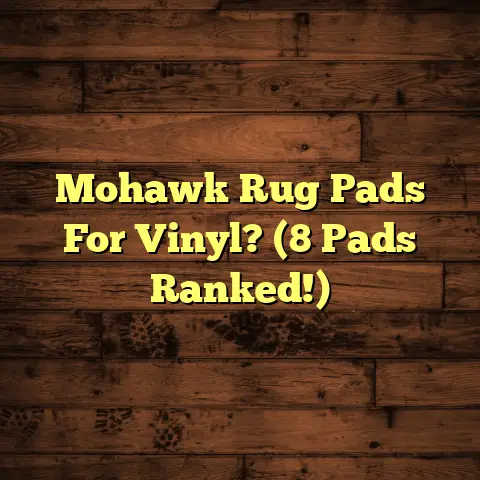Do Fleas Lay Eggs On Hardwood Floors?
Your Expert Guide
I’ve seen it all, from warped planks to the dreaded flea infestation.
Tonight, we’re diving into a question that’s bugged (pun intended!) many of my clients: “Do fleas lay eggs on hardwood floors?”
Imagine this: You’re relaxing after a long day, only to feel that telltale itch.
Your pet’s scratching like crazy, and you suspect the worst – fleas!
But you’ve got beautiful hardwood floors. Surely, they’re not the culprit, right?
Well, let’s find out.
1. Understanding Fleas
1.1 Flea Biology
Fleas are tiny, wingless insects designed for one thing: survival.
Their flattened bodies allow them to navigate easily through fur or carpet fibers.
And their powerful legs?
They use them to jump incredible distances.
Now, let’s talk reproduction.
The female flea is a veritable egg-laying machine. After a blood meal, she can lay dozens of eggs per day!
These eggs aren’t glued to the host; they fall off into the surrounding environment, which brings us to…your floors.
The flea life cycle consists of four stages: egg, larva, pupa, and adult.
Each stage is crucial for the flea’s survival, and understanding them is key to controlling an infestation.
1.2 Flea Life Cycle
The flea life cycle is fascinating (and a bit gross).
It starts with the egg, which is tiny, white, and resembles a grain of salt.
These eggs hatch into larvae, which are blind, worm-like creatures that feed on organic debris, including flea dirt (digested blood).
The larvae then spin a cocoon and enter the pupal stage.
This is a tough stage to crack because the pupa is resistant to many insecticides.
Finally, the adult flea emerges, ready to feed and reproduce.
The entire life cycle can take anywhere from a few weeks to several months, depending on environmental conditions like temperature and humidity.
2. Fleas and Their Habitats
2.1 Common Environments for Fleas
Fleas love warm, humid environments.
Think carpets, upholstery, pet bedding – these are flea paradises.
These surfaces provide shelter, food (flea dirt), and humidity, all essential for flea survival and reproduction.
Carpets, with their dense fibers, offer the perfect hiding place for flea larvae.
Upholstery, especially on furniture that pets frequent, can also become a breeding ground.
And pet bedding?
Well, that’s basically a flea buffet.
2.2 Hardwood Floors as a Habitat
Now, let’s talk about hardwood floors.
Compared to carpets, hardwood floors are less hospitable to fleas.
They lack the dense fibers that provide shelter and humidity.
However, that doesn’t mean fleas can’t survive on hardwood floors.
Cracks and crevices, gaps between planks, and dust bunnies lurking in corners can provide enough shelter for flea eggs and larvae.
Also, if you have pets, they can easily carry fleas onto your hardwood floors.
And remember those flea eggs that fall off the host?
Yep, they can end up on your hardwood.
A common misconception is that because hardwood is smooth and easy to clean, fleas can’t survive.
While it’s true that regular cleaning can help, it’s not a foolproof solution.
3. Do Fleas Lay Eggs on Hardwood Floors?
3.1 Flea Egg-Laying Behavior
Fleas are strategic about where they lay their eggs.
They prefer areas where the eggs will have the best chance of survival.
This means areas with a high concentration of hosts (your pets), warmth, and humidity.
While hardwood floors aren’t ideal, fleas will lay eggs there if no better options are available.
Think about it: your dog scratches, and eggs scatter onto the floor near his favorite napping spot.
Or, perhaps, eggs are near the baseboards or under furniture where the vacuum cleaner can’t reach.
The key is that fleas will lay eggs wherever they can, and hardwood floors are not off-limits.
3.2 Scientific Studies and Findings
While there aren’t many studies specifically examining flea egg-laying on hardwood floors, research on flea behavior can give us some insights.
According to a study published in the “Journal of Medical Entomology,” flea eggs are highly susceptible to desiccation (drying out).
This means that the drier the environment, the lower the chances of flea eggs surviving.
Hardwood floors, especially in dry climates, can be less favorable for egg survival compared to carpets or upholstery.
However, the study also found that flea eggs can survive in humid environments for several days.
So, if you live in a humid area, your hardwood floors might be more hospitable to flea eggs.
I have seen cases where homeowners in humid climates battle fleas even on hardwood.
A veterinarian I work with noted that homes with radiant floor heating can inadvertently create a more favorable breeding ground.
4. The Impact of Hardwood Floors on Flea Infestations
4.1 Factors Influencing Flea Survival on Hardwood Floors
Several factors can influence flea survival on hardwood floors:
- Texture: Smooth, polished floors are less hospitable than textured or unfinished floors.
- Cleanliness: Regular cleaning can remove flea eggs and larvae.
- Maintenance: Cracks and crevices can provide shelter for fleas.
- Humidity: High humidity levels increase flea survival.
- Pet Activity: Pets can carry fleas onto hardwood floors.
If you have cracks or crevices in your hardwood floors, sealing them can help reduce flea hiding spots.
Also, regular vacuuming and mopping can remove flea eggs and larvae.
4.2 Fleas vs. Other Surfaces
Compared to carpets, hardwood floors are less likely to harbor fleas.
Carpets provide a warm, humid, and protected environment that fleas love.
Upholstery is also a popular spot for fleas, especially on furniture that pets frequent.
However, hardwood floors are not immune to fleas.
They can still provide shelter for flea eggs and larvae, especially if they’re not properly maintained.
Here’s a quick comparison:
| Surface | Flea-Friendliness | Reasons |
|---|---|---|
| Carpets | High | Dense fibers provide shelter, humidity, and food (flea dirt). |
| Upholstery | Medium-High | Can provide shelter and humidity, especially on furniture that pets frequent. |
| Hardwood Floors | Low-Medium | Less hospitable due to lack of fibers, but cracks, crevices, and humidity can increase flea survival. Regular cleaning helps. |
| Tile/Laminate | Low | Smooth, non-porous surfaces are difficult for fleas to grip and offer little shelter. Easy to clean. |
5. Identifying Flea Infestations
5.1 Signs of Fleas in the Home
The most obvious sign of a flea infestation is, well, fleas!
You might see them jumping on your pets or crawling on your carpets.
Other signs include:
- Flea Dirt: Small, black specks that resemble dirt (but are actually flea feces).
- Bites: Itchy, red bumps on your skin, usually around your ankles.
- Pet Scratching: Excessive scratching, licking, or biting by your pets.
- Hair Loss: Patches of hair loss on your pets, especially around the base of the tail.
If you suspect a flea infestation, check your pets for fleas and flea dirt.
You can also use a white sock to walk around your carpets and hardwood floors.
If you see small, black specks on the sock, it’s likely flea dirt.
5.2 Diagnosing the Source of Infestation
Once you’ve confirmed a flea infestation, the next step is to find the source.
Are the fleas coming from your hardwood floors, your carpets, or your pets?
Start by inspecting your pet’s bedding and favorite spots.
If you find fleas or flea dirt, that’s a good indication that your pet is the source.
Next, check your carpets and upholstery.
Use a flashlight to look for fleas and flea dirt deep within the fibers.
Finally, inspect your hardwood floors.
Pay close attention to cracks, crevices, and areas under furniture.
If you find fleas or flea dirt in these areas, your hardwood floors might be contributing to the infestation.
I often tell my clients to consider where their pets spend the most time.
That’s usually ground zero.
6. Addressing Flea Infestations
6.1 Cleaning and Maintenance
Regular cleaning is essential for controlling flea infestations on hardwood floors.
Here are some tips:
- Vacuum Regularly: Vacuum your hardwood floors at least once a week, paying close attention to cracks, crevices, and areas under furniture.
- Mop Frequently: Mop your hardwood floors with a mild detergent to remove flea eggs and larvae.
- Seal Cracks and Crevices: Seal any cracks or crevices in your hardwood floors to eliminate flea hiding spots.
- Wash Pet Bedding: Wash your pet’s bedding regularly in hot water to kill fleas and their eggs.
- Declutter: Remove clutter from your home to eliminate flea hiding spots.
Also, consider using a steam cleaner to clean your hardwood floors.
The high heat can kill flea eggs and larvae.
6.2 Pest Control Options
If cleaning and maintenance aren’t enough, you might need to consider pest control options.
Here are some options:
- Flea Sprays: Use a flea spray specifically designed for hardwood floors. Be sure to follow the instructions carefully and keep pets and children away from treated areas.
- Flea Bombs: Flea bombs can be effective for treating large areas, but they can also be dangerous. Use them with caution and follow the instructions carefully.
- Professional Pest Control: If you’re struggling to control a flea infestation on your own, consider hiring a professional pest control company.
I always advise my clients to start with the least toxic option first.
And always, always read the labels!
Conclusion: Navigating Flea Challenges on Hardwood Floors
So, do fleas lay eggs on hardwood floors?
The answer is yes, but it’s not their preferred habitat.
Hardwood floors are less hospitable to fleas than carpets or upholstery, but they can still provide shelter for flea eggs and larvae, especially if they’re not properly maintained.
Understanding flea behavior and the specific challenges presented by hardwood floors is key to preventing and addressing flea infestations.
Stay vigilant in your efforts to prevent and address flea infestations, ensuring a comfortable and safe home environment.
Remember: Regular cleaning, proper maintenance, and targeted pest control can help you keep your hardwood floors flea-free.
And if all else fails, don’t hesitate to call a professional.
Good luck, and happy flea hunting!





